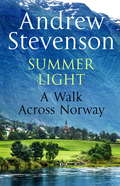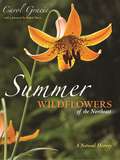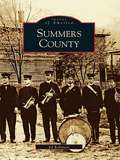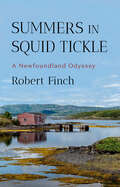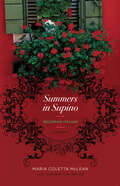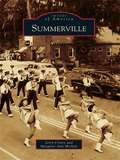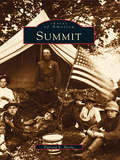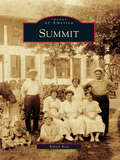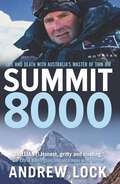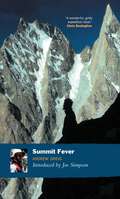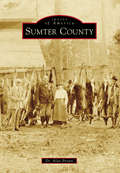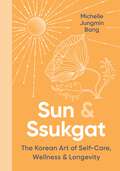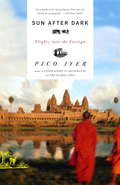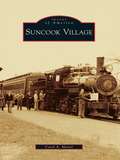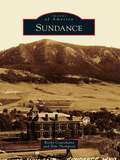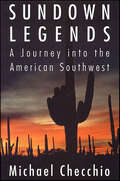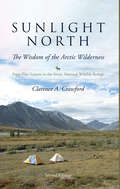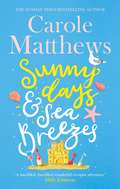- Table View
- List View
Summer Light: A Walk cross Norway
by Andrew StevensonEndless summer days and vast wilderness: Norway is an outdoor paradise almost too good to be true. Andrew Stevenson's affectionate luminous account reveals the magical appeal of this Scandinavian wonderland as he walks and cycles (and gets stuck in the odd snowdrift) across the country from Oslo to Bergen Staying at clifftop farms, climbing the country's highest mountains or taking a side trip far to the north of the Arctic circle, Andrew gets under Scandinavia's skin as only someone who has lived there and speaks the language can. As he introduces a land he loves to the new love of his life, he comes to peace with a country of light-and darkness.
Summer Wildflowers of the Northeast: A Natural History
by Carol GracieFrom the acclaimed author of Spring Wildflowers of the Northeast, a beautifully illustrated follow-up introduction to the summer-blooming wildflowers of the northeastern United States and CanadaThis exquisitely illustrated volume provides an accessible, in-depth introduction to summer-blooming wildflowers of the northeastern United States and Canada. Featuring more than 700 detailed color photos and a large, beautifully designed format, the book delves into the life histories of more than thirty-five wildflowers and their relatives, from common roadside favorites, such as asters and milkweeds, to interesting, lesser-known species, including Indian pipe and ginseng. Drawing on a wealth of personal experience and the latest scientific research, and presenting it all in terms anyone can understand, acclaimed naturalist and photographer Carol Gracie invites readers to enhance their appreciation of the beauty of these wildflowers by learning not just their names or how many petals they have, but what pollinates them, how their seeds are dispersed, how they interact with other plants and animals, how Native Americans and other people have used them, and other interesting facts.Each species is illustrated with a range of detailed color photos that not only capture its beauty but illustrate the features discussed in the text and show the plant in its environment alongside the pollinators, herbivores, or seed dispersers with which, in many cases, the wildflower has evolved. Other topics covered include the naming of wildflowers; pathogens and pests; related species in other parts of the world; and wildflowers in history, literature, and art.Presenting authoritative information in an inviting style, Summer Wildflowers of the Northeast is an ideal volume for wildflower lovers, outdoor enthusiasts, naturalists, students, and more.Showcases the most spectacular summer-blooming wildflowers of the northeastern United States and CanadaFeatures more than 700 stunning full-color photosCovers the life histories, lore, and uses of more than 35 species and their relativesCombines the latest scientific research with an easy-to-read styleFeatures species accounts for these wildflowers:Alpine Wildflowers ● American Cranberry ● American Ginseng ● American Lotus ● Asters ● Beechdrops ● Blackberry-lily ● Bog Orchids ● Broad-leaved Helleborine ● Buckbean ● Bunchberry ● Cardinal Flower ● Chicory ● Common Milkweed ● Common Mullein ● Evening-Primrose ● Fringed Gentian ● Fringed Orchids ● Goldenrods ● Grass-of-Parnassus ● Indian Pipe ● Jewelweed ● Jimsonweed ● Lilies ● Patridge-berry ● Passion-flowers ● Pipsissewa ● Prickly Pear ● Purple Pitcher Plant ● Queen Anne’s Lace ● Showy Lady-slipper ● Swamp Rose-mallow ● Wild Leek ● Wild Lupine ● Yellow Pond-lily
Summer at the French Olive Grove: The perfect romantic summer escape
by Sophie ClaireCould love be the biggest adventure of all? A new gorgeous, escapist romance from Sophie Claire, set in sunny Provence.Could love be the biggest adventure of all?Filmmaker Lily's life is all about work and adventure. So when she suffers an accident on her travels and finds herself recuperating in the quiet French seaside village where she spent her childhood, she can't wait to escape. Not least because Olivier - Lily's childhood friend and former crush, who she has spent the last thirteen years avoiding - is staying next door . . . Strong-minded masterbaker Olivier is happily settled in St Pierre, preparing to marry and put down roots. But Lily's return to the village risks turning his carefully-laid plans upsidedown, and as the pair rediscover their familiar rivalry and fun, sparks fly.Is Lily really as fearless and independent as she seems on the surface - or is she just running from the past? And what if Olivier is the only one who can teach her what it really means to be brave?(P) 2021 Hodder & Stoughton Ltd
Summer at the French Olive Grove: The perfect romantic summer escape
by Sophie ClaireCould love be the biggest adventure of all?Filmmaker Lily's life is all about work and adventure. So when she suffers an accident on her travels and finds herself recuperating in the quiet French seaside village where she spent her childhood, she can't wait to escape. Not least because Olivier - Lily's childhood friend and former crush, who she has spent the last thirteen years avoiding - is staying next door . . . Strong-minded masterbaker Olivier is happily settled in St Pierre, preparing to marry and put down roots. But Lily's return to the village risks turning his carefully-laid plans upsidedown, and as the pair rediscover their familiar rivalry and fun, sparks fly.Is Lily really as fearless and independent as she seems on the surface - or is she just running from the past? And what if Olivier is the only one who can teach her what it really means to be brave?Readers love Summer at the French Olive Grove:'Romantic . . . heartwarming and uplifting' - 5 STARS'The perfect summery read' - 5 STARS'Heartwarming, humorous and heartbreaking' - 5 STARS'Glorious setting . . . you can almost feel the warm sunshine on your skin' - 5 STARS'A stunning story . . . heart, love, loss and a delightful cast of characters' - 5 STARS
Summer at the Vineyard: Escape to France in the best laugh-out-loud sunny laugh-out-loud holiday read this summer (The French Escapes)
by Fliss Chester'I LOVED this book...a delicious modern day Jilly Cooper. Five stars' - Jules, Amazon reviewerThe perfect beach read, sizzling with sun and fizzing with flirtation!Jenna Jenkins needs to get away. She's been unceremoniously sacked from her job and it's make or break time with her boyfriend Angus, so a summer job at the beautiful Chateau Montmorency in the south of France seems like the perfect solution. Planning the party of the century, dining out with suave Frenchmen, and giving in to a little temptation among the vines are all in a day's work... but is there a secret lurking in the chateau cellars?Caught in a trap she can't talk - or drink - herself out of, Jenna is well and truly corkscrewed. Things are really hotting up under the sun when a mysterious benefactor helps her out of her jam. But why does he seem so familiar...?Jet down to the South of France for fun in the vineyards! Ideal for fans of Jilly Cooper, Shari Low, Tracy Bloom, Jenny Oliver and Heidi Swain.Readers love Fliss Chester:'A fabulously entertaining romantic romp, jam-packed with humour. Five stars' - Rupert, Amazon reviewer'A fast-paced and fun romp...the perfect romantic read. Five stars' - Nicky, Amazon reviewer'Fun, engaging romp of a novel. Five stars' Charlie, Amazon reviewer'It's fun, glamorous and saucy! Five stars' Emma, Amazon reviewer
Summer in the Vineyards: a delicious summer tale of hidden secrets and eternal love
by Natalie Meg EvansA gorgeous novel set in the French countryside. Perfect for fans of The Keeper of Lost Things and The Hourglass.Shauna Vincent has just learned that the job she set her heart on has gone to a well-connected rival. Devastated, she accepts an offer from an old family friend, and soon Shauna is deep in the French countryside with endless hours to explore the magical landscape around her. But can the charming Laurent de Chemignac, owner of the local chateau, help her untangle the secret that this little French castle amongst the vines might be hiding...'Natalie's books are a treasure trove of vibrant, vivid stories, memorable characters and pacy writing!' Tracy Rees, bestselling author of Amy Snow and The HourglassAlso by Natalie Meg Evans:The Wardrobe MistressThe Girl who Dreamed of ParisThe Dress Thief[Summer in the Vineyards was previously published as A Gown of Thorns]
Summers County (Images of America)
by Ed RobinsonIt was the pull of the steam engine that brought residents to Summers County after the Civil War. With Hinton as a bustling hub of the Chesapeake and Ohio Railroad, Summers County found itself along the path of goods and travelers going to and from Richmond and the Midwest. Surrounded by breathtaking scenery and good mountain air, residents prospered in the county, building beautiful homes and lively communities. Lumber and riverboat traffic also added to the scene, although it was around the C&O that the area's culture truly thrived. Legends such as John Henry, the Steel Drivin' Man who out-drilled a steam drill while digging the Great Bend Tunnel, came to symbolize the grit-and-steel consciousness of this West Virginia county.Life was good, but work was hard. When diesel engines became the norm in the 1950s, Summers County's fabric began to change. Today tourism and recreation are the greatest industries in the area, but residents have not forgotten their past. Each year the county taps into its railroading heritage with festivals and celebrations, and efforts are being made to preserve some of Hinton's unique architecture.
Summers in Squid Tickle: A Newfoundland Odyssey
by Robert FinchAn acclaimed nature writer’s moving recollection of his two decades as a summer resident of a Newfoundland fishing village, originally known as Squid Tickle. Robert Finch arrived in Newfoundland in the summer of 1995 heartsick, directionless, his old life on Cape Cod in tatters. Burnside, located in Newfoundland’s rugged northeast, seemed like a good place to heal. The coastal village was home to just fifty year-round residents, and accessible only by a hundred-mile ferry crossing. Finch was drawn in by the landscape of low ridges and archipelagos of rocky islands, but he returned to Burnside for its strong sense of community, and the possibility that it might provide a new pattern for his ow life. Eventually Finch became a summer resident, buying a house, playing organ for the church, and fishing the area’s waters. Offering a portrait of the Newfoundland character and culture, Summers in Squid Tickle explores how three generations of the village have grappled with the changes of the past century—from the rise and collapse of commercial cod fishing, and the migration of young people away from the outport, to the distant hope for tourism and new industries to sustain a disappearing way of life. With characteristically elegant prose and deep sensitivity, Finch introduces us to Squid Tickle’s inhabitants—a collection of hardy fishermen, vigorous retirees, and close neighbors, as well as the woman who would become his wife. Even as the fish in Squid Tickle’s waters vanish, Finch sketches the enduring relationship of a village with the sea—for food, work, leisure, and a rich community life—in the midst of an unforgiving but stunning landscape. Summers in Squid Tickle speaks to the desire we all have in our era to seek quiet, and to reevaluate our connection to each other and the natural world.
Summers in Supino: A Memoir
by Maria McLean&“A vivid memoir&” of a time spent in Supino, Italy &“quickly transports readers into the charm and richness of village life . . . a story of love and family.&” (Publishers Weekly) Every summer Maria and her husband, Bob, went to their little house in the Italian village of Supino, and every year it was a new adventure. Only in Supino would you find a pizzeria in a sheep pasture, a seafood restaurant hidden in the woods, or an electrical cord draped from one balcony to the next so neighbours could share power. In Supino, they celebrate the first figs of the season; host watermelon, azalea, and artichoke festivals; and take pleasure in the magical view of the stars in the summer sky. Written with humour and heart, Summers in Supino is Maria Coletta McLean&’s memoir of these summers with Bob, as she becomes accustomed to the town her father grew up in and the peculiarities of the people who live there. Cousin Guido argues with their neighbour over who can plant a grapevine and therefore reap the harvest. Villagers debate whether one neighbour can trade the installation of some terra cotta tiles and the use of a pizza oven (he has yet to build) for the land beneath Bob and Maria&’s patio. And as Maria comes to understand her connection to this wonderful place, Bob proposes they open a coffee bar on the piazza. Full of wonderfully vivid stories of Italy, Summers in Supino also explores loss, grief, and the restorative power of community.
Summers with Lincoln: Looking for the Man in the Monuments
by James A. PercocoA journey across America revealing &“the history of how seven of these monuments came to be . . . and what they mean to us today&” (The Washington Times). Across the country, in the middle of busy city squares and hidden on quiet streets, there are nearly two hundred statues erected in memory of Abraham Lincoln. No other American has ever been so widely commemorated. A few years ago, Jim Percoco, a history teacher with a passion for both Lincoln and public sculpture, set off to see what he might learn about some of these monuments—what they meant to their creators and to the public when they were unveiled, and what they mean to us today. The result is a fascinating chronicle of four summers on the road looking for Lincoln stories in statues of marble and bronze. Percoco selects seven emblematic works, among them Thomas Ball&’s Emancipation Group, erected east of the Capitol in 1876 with private funds from African Americans and dedicated by Frederick Douglass; Augustus Saint-Gaudens&’s majestic Standing Lincoln of 1887 in Chicago; Paul Manship&’s 1932 Lincoln the Hoosier Youth, in Fort Wayne, Indiana; and Gutzon Borglum&’s 1911 Seated Lincoln, struggling with the pain of leadership, beckoning visitors to sit next to him on his metal bench in Newark, New Jersey. At each stop, Percoco chronicles the history of the monument, spotlighting its artistic, social, political, and cultural origins. His descriptions draw fresh meaning from mute stone and cold metal—raising provocative questions not just about who Lincoln might have been, but about what we&’ve wanted him to be in the monuments we&’ve built.
Summerville
by Margaret Ann Michels Jerry CrottySummerville's original motto, Sacra Pinus Esto, "The Pine is Sacred," hints at how serious the founders were about protecting their towering indigenous pines. Summerville owes its settlement--and early 20th-century development as an international tourism destination--to the fragrant cool air provided by the shade of the grand pines. Settled in the late 1600s by plantation owners along the Ashley River as an escape from summer heat, Summerville later became a retreat from cold northern winters. Today the town is known for its annual Flowertown Festival. The new town slogan, "The Flower Town in the Pines," is a friendlier version of the first, combining healthy respect for the ancient pines with love for the multicolored blossoms that appear anew each spring. The village is a combination of small town and bustling suburb, with plenty of Southern history to explore.
Summit (Images of America)
by Patricia E. MeolaWith a history dating back to 1664, Summit, New Jersey, has evolved from a pastoral town of farms and rolling hills to a populated suburb of Manhattan.In this original collection of images, author and local historian Patricia E. Meola takes readers on a journey into Summit's past. Witness the growth and change that have occurred in Summit since its incorporation in 1899 in this fascinating pictorial history. Through nearly 200 postcard images, Summitcelebrates a city known for its gracious, tree-lined streets, the reputation of its public and private schools, the activism of countless city volunteers, and its thriving opportunities for culture and adult education. In the early days of the community's development, many residents were seasonal (this attribute of the population changed as it became easier to live in the country and work in the city). Some of the postcards that were sent to friends and relations by early summer inhabitants have been reproduced in this book.
Summit (Images of America)
by Robert KottSummit, fittingly named after its location astride a rise, was built on that low ridge crossed by travelers seeking a convenient route into America's interior. As a portal to the North American interior, Summit's land has witnessed the travels and pauses of Native Americans, French explorers and missionaries, fur traders, the English, and finally Colonial Americans. To this day, it remains synonymous with unsurpassed transportation advantages, having stimulated considerable commercial, industrial, and urban growth. From its earliest hut to its latest futuristic library, Summit has played an irreplaceable role in the progress of the United States.
Summit 8000: Life and Death with Australia's Master of Thin Air
by Andrew LockA thrilling memoir of the spectacular high-altitude mountaineering achievements of Andrew Lock: the only Australian to have summited all fourteen 8000-metre peaks in the world, including Mount Everest—twice. We learn 'why does he do it?' Why does anyone take on such a challenge, knowing how easily they might be killed? Andrew Lock gives us a gripping account of his death-defying ascents and explains his passion for climbing in small teams, or solo, without Sherpas or bottled oxgyen. His story is one of extraordinary passion, self-motivation, perseverance and resilience, as he leads us through his sixteen-year odyssey to achieve the Grand Slam of Himalayan mountaineering. We are taken through the victories, the near-misses and the tragedies. The intense human drama of the expeditions infuses Summit 8000—funny, fierce and always fascinating stories about survival, climbing rivalries and mountaineering politics. The remote and stunning landscapes and cultures that Andrew encounters on his journeys add rich texture to his tale, culminating in his 2014 trip to Everest, where he was witness to the deadliest avalanche in the peak's history.
Summit Fever
by Andrew GreigA &“wonderful&” memoir about mountain climbing—and the risk, joy, and adventure of being alive (Chris Bonington). Shortlisted for the Boardman Tasker Prize for Mountain Literature When poet Andrew Greig was asked by Scottish mountaineer Mal Duff to join his ascent of the Mustagh Tower in the Karakoram Himalayas, he had a poor head for heights and no climbing experience whatsoever. The result is this unique book. Known for its candor and wit, and the beauty of its writing, Summit Fever is the story of a newcomer to mountain climbing facing a challenge beyond his expectations—&“an excellent read, one of the best expedition books so far&” (Climber).
Sumter County
by Alan BrownSumter County was founded on December 18, 1832, on land ceded to the United States by the Choctaw Indians in the Treaty of Dancing Rabbit Creek. Almost immediately, settlers began pouring in from Georgia, Virginia, Tennessee, and the Carolinas. In the 19th and early-20th centuries, most of the residents were farmers; however, following the infestation of the boll weevil, many turned to raising cattle and growing timber. Every November, hundreds of hunters descend upon Sumter County in hopes of harvesting one of the thousands of deer that live on the rolling prairies and in the oak forests lining the Tombigbee River. With the help of Ruby Pickens Tartt, scores of ethnomusicologists, including John and Alan Lomax, traveled hundreds of miles to the red clay country of Sumter County in the 1930s, 1940s, and 1950s to record African American folk songs from people like Vera Hall and Dock Reed.
Sun & Ssukgat: The Korean Art of Self-Care, Wellness & Longevity
by Michelle Jungmin BangA charming, life-changing guide to living a longer, happier, healthier life, rooted in Korean self-care. From the country scientists predict will top longevity charts in 2030.Ssukgat, or Chrysanthemum greens, are treasured in Korean culture for their healing abilities. You can coax its withered stalks to bloom again, with sun, water, soil, and care. It’s a fitting metaphor for eco-entrepreneur and CEO Michelle Jungmin Bang, who found herself in excruciating pain due to the constant sacrificing of her health and wellness for work—a trade many of us make daily.Thus started her fascinating journey to overhaul her health and reconnect with her heritage in South Korea. She found answers in the mountains with Buddhist nuns and the keys to microbiome health, a seaside village with haenyeo (female free divers who forage for seafood) and their practice of healing with breath, centenarians with easily adoptable daily habits, and Korean bathhouse culture and its “wellness for everyone” approach to youthful skin. Natural, effective, and environmentally conscious, these traditions have been passed down for centuries in Asia, like gifted heirlooms, and they quietly and radically shift our philosophies on well-being towards preventative care.Informed by her travels, research, and East-West nutrition training, Michelle reflects on how we can eat for healing, live sustainably, reconnect with nature, form deeper relationships with the Korean concept of Jeong (the warm, invisible connection between loved ones and places), and more. Also included are simple and delicious healing recipes that can be used for recovery, like a mushroom broth the Buddhist nuns turn to for colds; her grandmother’s secret Myeolchi (anchovy) broth; Samgyetang (chicken and ginseng soup) for combatting fatigue; as well as Hoedeopbap (raw fish bibimbap), her most-requested dish that requires no cooking.Stunningly written and accompanied by Michelle’s gorgeously hand-drawn illustrations and infographics, Sun & Ssukgat is on a mission to empower anyone stuck in the unhealthy whirlwind of modern life to transform our well-being in the little things we do every single day.This beautifully designed book is perfect for:Fans of Korean and Asian food and cultureGifting to friends and familyFood-as-medicine enthusiasts seeking natural ways to improve their healthTravel aficionados and environmentally-conscious readersProfessionals and students looking to boost performance and wellness
Sun After Dark: Flights into the Foreign
by Pico IyerOne of the best travel writers now at work in the English language brings back the sights and sounds from a dozen different frontiers. A cryptic encounter in the perfumed darkness of Bali; a tour of a Bolivian prison, conducted by an enterprising inmate; a nightmarish taxi ride across southern Yemen, where the men with guns may be customs inspectors or revolutionaries- these are just three of the stops on Pico Iyer's latest itinerary. But the true subject of Sun After Dark is the dislocations of the mind in transit. And so Iyer takes us along to meditate with Leonard Cohen and talk geopolitics with the Dalai Lama. He navigates the Magritte-like landscape of jet lag, "a place that no human had ever been until forty or so years ago." And on every page of this poetic and provocative book, he compels us to redraw our map of the world.
Suncook Village
by Carol MartelLocated within the boundaries of the towns of Allenstown and Pembroke, Suncook, first granted as a township in 1728, has developed a rich history all its own. Railroad transportation was instrumental to the establishment and growth of three large textile mills. The first railroad system, the Concord and Portsmouth line, began in 1852. A second line, the Suncook Valley Railroad, followed in 1869. Drawn by advertisements in Canadian newspapers, French Canadian workers began migrating from Quebec in large numbers. By the late 1800s, Suncook had become known as "le Petit Canada." The power of the Suncook and Merrimack Rivers, scenic beauty in the area, and the connectivity brought through transportation helped transform a small industrial village into a vibrant and lasting community.
Sundance
by Rocky Courchaine Pam ThompsonSundance, in the northeast corner of Wyoming, may not be the only place with that name, but it is the original Sundance--the place where the Kid got his name. There was no settlement of any sort when Crook County was created in 1875. The town was founded in 1878, named after the mountain that stands south of town where the Plains tribes held their sun dance ceremonies. Sundance is not that different from the many other small towns that sprang to life in the boom of gold, cattle, and oil throughout the West, but it is different in that it has ridden through the booms and the busts and still survives. This book contains images of people's lives as they worked and played, lived and died. It tells of those who passed through, and those who stayed and helped the community establish its roots and grow.
Sundays with Vlad: From Pennsylvania to Transylvania, One Man's Quest to Live in the World of the Undead
by Paul BibeauFrom the moment his bully of an older sister jumped out of a dresser drawer, baring her convincing glow-in-the-dark vampire fangs, Paul Bibeau was sold on monsters. Though he claims to have been scarred for life by this traumatic childhood experience, he developed an uncanny obsession with the undead. Years later, his fixation led him to revise his honeymoon plans with his unsuspecting wife to include a side-trip to Wallachia, Romania to visit the historical Castle Dracula -- the castle of Vlad the Impaler. Clutching his guidebook like a Bible, Bibeau set off on a sometimes disturbing, often hilarious journey through the legend of Dracula and the country from whence he came. From movies to novels to the cereal box, Dracula has become quite the cult figure over the centuries, though locals barely bat an eyelid at the surprising breadth of the subculture devoted to him. As if visiting the home of the legendary Dracula weren't enough, Bibeau digs through Bram Stoker's original manuscript, meets with the president of the Dracula Fan Club, and even marches in the Transylvania Day Parade as a giant garlic bulb, all in the hopes of getting at the stone cold heart of vampire mania. Filled with equal parts humor, irony, and reverence, Sundays with Vlad is an alternative travelogue that will appeal both to vampire fans as well as those fascinated by a segment of society they never see during the light of day.
Sundown Legends: A Journey into the American Southwest
by Michael ChecchioStanding atop the wall of California, Michael Checchio decided to head out for Saline and Death Valley, the canyonlands of Arizona and Utah and the uplands of New Mexico. He would re-visit old haunts and explore new ones-and in so doing rediscover a world he thought he already knew.In Sundown Legends, Checchio offers up the American Southwest as a spiritual repository and source of inspiration. On his travels he talked to individuals whose imaginations have been shaped by the power of this desert landscape, including Ken Sleight, the Utah wilderness outfitter, who was the inspiration for a character in THE MONKEY WRENCH GANG and novlist John Nichols, author of the MILAGRO BEANFIELD WAR, who wandered into Taos in the late sixties and found a place to make his stand. Like Michael Wallis, Michael Checchio is a powerfully gifted writer who has created an intimate and lasting portrait of one of our last remaining wild places.
Sunker's Deep (Icebreaker Trilogy #2)
by Lian TannerAction, adventure, and mystery surround the Sunkers, a band of children who live in a submarine, as they try to survive a war in Book Two of the Icebreaker Trilogy. <P><P> Sharkey is a Sunker--he was born on a fortunate tide, and everyone in the giant submersible Rampart knows it. The trouble is his life is based on a lie. He's been a fake hero for years, but when tragedy strikes, he must become a real one. And he has no idea how to go about it. <P><P> Meanwhile, on land, Petrel, Fin, and the crew of the Oyster are on a mission to bring lost knowledge back into the world, a mission they have no idea how to carry out.
Sunlight North: Forty-Five Seasons in the Arctic National Wildlife Refuge
by Clarence CrawfordIn Sunlight North: The Wisdom of the Arctic Wilderness, Clarence A. Crawford writes about some of his experiences in the Arctic National Wildlife Refuge, recalling the many ways it has shaped his life during the past forty-five years. The bulk of these chapters narrate some aspect of travel in the Arctic. Several deal with contemporary attitudes that may adversely affect the Refuge and other wilderness areas. And several chapters deal with the mythical and philosophical underpinnings of why people quest, in the wilderness and elsewhere. Crawford is acutely aware that one section of the Refuge, the 1002 area of the Coastal Plain, has not received wilderness status and is continually under the threat of oil drilling. That protection, he fervently hopes, will be accomplished in his or his children's lifetimes.
Sunny Days and Sea Breezes: The PERFECT feel-good, escapist read from the Sunday Times bestseller
by Carole MatthewsTHE TOP TEN SUNDAY TIMES BESTSELLER Winner of the RNA Romantic Comedy Novel of the Year award 'A life-affirming story full of joy and hope' CATHY BRAMLEY 'A sun-filled, fun-filled wonderful escapist adventure' MILLY JOHNSON When does time out become the time of your life? Jodie Jackson is all at sea, in every sense. On a ferry bound for the Isle of Wight, she's leaving her London life, her career, and her husband behind. She'd like a chance to turn back the clocks, but she'll settle for some peace and quiet on her brother Bill's beautifully renovated houseboat, Sunny Days. But from the moment Jodie steps aboard her new home, it's clear she'll struggle to keep herself to herself. If it isn't Marilyn, who cleans for Bill and is under strict instructions to look after Jodie, then it's Ned, the noisy sculptor on the next-door houseboat. Ned's wood carving is hard on the ears, but it's made up for by the fact that he's rather easy on the eyes.Bustled out of the boat by Marilyn and encouraged to explore with Ned, Jodie soon delights in her newfound freedom. But out of mind isn't out of sight, and when her old life comes knocking Jodie is forced to face reality. Will she answer the call or choose a life filled with Sunny Days and Sea Breezes?An absolute must-read from the queen of fun-filled and life-affirming fiction, Sunny Days and Sea Breezes will make your heart sing!'A life-affirming story full of joy and hope' CATHY BRAMLEY'A sun-filled, fun-filled wonderful escapist adventure' MILLY JOHNSON'A wonderful setting where dark clouds part to reveal a happy ending' KATIE FFORDE'A bright and breezy summer story, the next best thing to a seaside trip' SUNDAY MIRROR'A delightful summer read' HELLO!'Packed full of Matthews' signature charm, this has original characters and an escapist setting' WOMAN'Perfect escapism'BELLA'A bright, breezy, summery story!' BEST'A warm summer read' CHOICE
